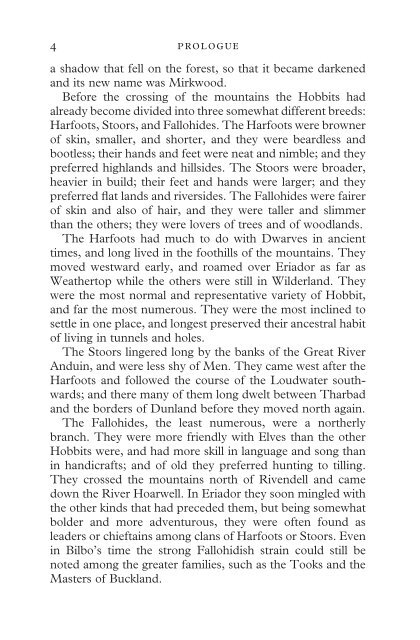- Page 3 and 4: iii THE FELLOWSHIP OF THE RING bein
- Page 6 and 7: CONTENTS Note on the Text Note on t
- Page 10 and 11: NOTE ON THE TEXT J.R.R. Tolkien’s
- Page 12 and 13: note on the text the detailed index
- Page 14 and 15: note on the text rections, as error
- Page 16 and 17: note on the text xvii Isengard (198
- Page 18 and 19: note on the text out before us, sor
- Page 20 and 21: note on the 50 th anniversary editi
- Page 22 and 23: note on the 50 th anniversary editi
- Page 24 and 25: FOREWORD TO THE SECOND EDITION This
- Page 26 and 27: foreword to the second edition xxvi
- Page 28: foreword to the second edition xxix
- Page 31: 2 prologue possessed from the first
- Page 35 and 36: 6 prologue demanded of them was tha
- Page 37 and 38: 8 prologue arrows. If any Hobbit st
- Page 39 and 40: 10 prologue clannish and reckoned u
- Page 41 and 42: 12 prologue 3 Of the Ordering of th
- Page 43 and 44: 14 prologue in tales and legends of
- Page 45 and 46: 16 prologue after ages alone in the
- Page 47 and 48: 18 note on the shire records and Fr
- Page 49 and 50: 20 note on the shire records were f
- Page 52: THE FELLOWSHIP OF THE RING being th
- Page 56 and 57: Chapter 1 A LONG-EXPECTED PARTY Whe
- Page 58 and 59: a long-expected party 29 consulting
- Page 60 and 61: a long-expected party 31 had me up
- Page 62 and 63: a long-expected party 33 not a sing
- Page 64 and 65: a long-expected party 35 but as the
- Page 66 and 67: a long-expected party 37 There were
- Page 68 and 69: a long-expected party 39 silence, a
- Page 70 and 71: a long-expected party 41 Bagginses
- Page 72 and 73: a long-expected party 43 ‘Oh, the
- Page 74 and 75: a long-expected party 45 ‘I don
- Page 76 and 77: a long-expected party 47 Pursuing i
- Page 78 and 79: a long-expected party 49 For MILO B
- Page 80 and 81: a long-expected party 51 Otho would
- Page 82 and 83:
a long-expected party 53 the point
- Page 84 and 85:
Chapter 2 THE SHADOW OF THE PAST Th
- Page 86 and 87:
the shadow of the past 57 well-trod
- Page 88 and 89:
the shadow of the past 59 ‘Then H
- Page 90 and 91:
the shadow of the past 61 was on th
- Page 92 and 93:
the shadow of the past 63 fell on m
- Page 94 and 95:
the shadow of the past 65 hobbits h
- Page 96 and 97:
the shadow of the past 67 of his po
- Page 98 and 99:
the shadow of the past 69 from Saur
- Page 100 and 101:
the shadow of the past 71 mother, d
- Page 102 and 103:
the shadow of the past 73 ‘You ou
- Page 104 and 105:
the shadow of the past 75 a present
- Page 106 and 107:
the shadow of the past 77 took it u
- Page 108 and 109:
the shadow of the past 79 ‘All th
- Page 110 and 111:
the shadow of the past 81 I should
- Page 112 and 113:
the shadow of the past 83 ‘But I
- Page 114 and 115:
Chapter 3 THREE IS COMPANY ‘You o
- Page 116 and 117:
three is company 87 portents on the
- Page 118 and 119:
three is company 89 evening Frodo g
- Page 120 and 121:
three is company 91 expected to see
- Page 122 and 123:
three is company 93 They went in si
- Page 124 and 125:
three is company 95 expedition. ‘
- Page 126 and 127:
three is company 97 Frodo, going ou
- Page 128 and 129:
three is company 99 ‘I can’t sa
- Page 130 and 131:
three is company 101 that it had pu
- Page 132 and 133:
three is company 103 something dark
- Page 134 and 135:
three is company 105 wood at night!
- Page 136 and 137:
three is company 107 and his compan
- Page 138 and 139:
three is company 109 tions. You are
- Page 140 and 141:
three is company 111 I may not see
- Page 142 and 143:
a short cut to mushrooms 113 I don
- Page 144 and 145:
a short cut to mushrooms 115 over t
- Page 146 and 147:
a short cut to mushrooms 117 ‘Why
- Page 148 and 149:
a short cut to mushrooms 119 edge o
- Page 150 and 151:
a short cut to mushrooms 121 from a
- Page 152 and 153:
a short cut to mushrooms 123 out a
- Page 154 and 155:
a short cut to mushrooms 125 supper
- Page 156 and 157:
a short cut to mushrooms 127 subsid
- Page 158 and 159:
a conspiracy unmasked 129 tinued to
- Page 160 and 161:
a conspiracy unmasked 131 could be
- Page 162 and 163:
a conspiracy unmasked 133 There was
- Page 164 and 165:
a conspiracy unmasked 135 ‘I thin
- Page 166 and 167:
a conspiracy unmasked 137 when he s
- Page 168 and 169:
a conspiracy unmasked 139 With foes
- Page 170 and 171:
a conspiracy unmasked 141 stories a
- Page 172 and 173:
Chapter 6 THE OLD FOREST Frodo woke
- Page 174 and 175:
the old forest 145 branches swayed
- Page 176 and 177:
the old forest 147 the clearing, th
- Page 178 and 179:
the old forest 149 flows south-west
- Page 180 and 181:
the old forest 151 impossible to cl
- Page 182 and 183:
the old forest 153 head swam. There
- Page 184 and 185:
the old forest 155 ‘I suppose we
- Page 186 and 187:
the old forest 157 dancing along th
- Page 188 and 189:
the old forest 159 with hundreds of
- Page 190 and 191:
Chapter 7 IN THE HOUSE OF TOM BOMBA
- Page 192 and 193:
in the house of tom bombadil 163
- Page 194 and 195:
in the house of tom bombadil 165 he
- Page 196 and 197:
in the house of tom bombadil 167 he
- Page 198 and 199:
in the house of tom bombadil 169 we
- Page 200 and 201:
in the house of tom bombadil 171 fo
- Page 202 and 203:
in the house of tom bombadil 173 we
- Page 204 and 205:
in the house of tom bombadil 175 wi
- Page 206 and 207:
fog on the barrow-downs 177 light l
- Page 208 and 209:
fog on the barrow-downs 179 glimpse
- Page 210 and 211:
fog on the barrow-downs 181 with Fr
- Page 212 and 213:
fog on the barrow-downs 183 When he
- Page 214 and 215:
fog on the barrow-downs 185 wavered
- Page 216 and 217:
fog on the barrow-downs 187 Wake no
- Page 218 and 219:
fog on the barrow-downs 189 ‘Here
- Page 220 and 221:
fog on the barrow-downs 191 shapes
- Page 222 and 223:
fog on the barrow-downs 193 twiligh
- Page 224 and 225:
Chapter 9 AT THE SIGN OF THE PRANCI
- Page 226 and 227:
at the sign of the prancing pony 19
- Page 228 and 229:
at the sign of the prancing pony 19
- Page 230 and 231:
at the sign of the prancing pony 20
- Page 232 and 233:
at the sign of the prancing pony 20
- Page 234 and 235:
at the sign of the prancing pony 20
- Page 236 and 237:
at the sign of the prancing pony 20
- Page 238 and 239:
at the sign of the prancing pony 20
- Page 240 and 241:
at the sign of the prancing pony 21
- Page 242 and 243:
Chapter 10 STRIDER Frodo, Pippin, a
- Page 244 and 245:
strider 215 On Monday one came down
- Page 246 and 247:
strider 217 he warns and he says ta
- Page 248 and 249:
strider 219 Mr. FRODO BAGGINS, BAG
- Page 250 and 251:
strider 221 much, Barliman, but eve
- Page 252 and 253:
strider 223 Frodo read the letter t
- Page 254 and 255:
strider 225 a rough road tomorrow.
- Page 256 and 257:
strider 227 One was muttering; and
- Page 258 and 259:
strider 229 I had been there to see
- Page 260 and 261:
a knife in the dark 231 awake! fear
- Page 262 and 263:
a knife in the dark 233 might as we
- Page 264 and 265:
a knife in the dark 235 missed a da
- Page 266 and 267:
a knife in the dark 237 quick as li
- Page 268 and 269:
a knife in the dark 239 ‘I am bei
- Page 270 and 271:
a knife in the dark 241 At the day
- Page 272 and 273:
a knife in the dark 243 But long ag
- Page 274 and 275:
a knife in the dark 245 branches,
- Page 276 and 277:
a knife in the dark 247 ‘I wonder
- Page 278 and 279:
a knife in the dark 249 Rangers pas
- Page 280 and 281:
a knife in the dark 251 Enchantment
- Page 282 and 283:
a knife in the dark 253 face was a
- Page 284 and 285:
a knife in the dark 255 Over the li
- Page 286 and 287:
Chapter 12 FLIGHT TO THE FORD When
- Page 288 and 289:
flight to the ford 259 and lifted u
- Page 290 and 291:
flight to the ford 261 scanty, coar
- Page 292 and 293:
flight to the ford 263 At once they
- Page 294 and 295:
flight to the ford 265 Shire, but i
- Page 296 and 297:
flight to the ford 267 went on, dow
- Page 298 and 299:
flight to the ford 269 There stood
- Page 300 and 301:
flight to the ford 271 ‘For a cou
- Page 302 and 303:
flight to the ford 273 way and up i
- Page 304 and 305:
flight to the ford 275 and he felt
- Page 306 and 307:
flight to the ford 277 the bottom o
- Page 308 and 309:
flight to the ford 279 Frodo looked
- Page 310:
flight to the ford 281 as it carrie
- Page 314 and 315:
Chapter 1 MANY MEETINGS Frodo woke
- Page 316 and 317:
many meetings 287 ‘Yes, I, Gandal
- Page 318 and 319:
many meetings 289 be alarmed!’ sa
- Page 320 and 321:
many meetings 291 and there seemed
- Page 322 and 323:
many meetings 293 made him laugh. T
- Page 324 and 325:
many meetings 295 ‘More than a me
- Page 326 and 327:
many meetings 297 white, nearly as
- Page 328 and 329:
many meetings 299 answered. ‘It i
- Page 330 and 331:
many meetings 301 have disturbed me
- Page 332 and 333:
many meetings 303 was about him aga
- Page 334 and 335:
many meetings 305 his scabbard of c
- Page 336 and 337:
many meetings 307 of folk of Men an
- Page 338 and 339:
many meetings 309 my head, and he s
- Page 340 and 341:
Chapter 2 THE COUNCIL OF ELROND Nex
- Page 342 and 343:
the council of elrond 313 especiall
- Page 344 and 345:
the council of elrond 315 ‘You ha
- Page 346 and 347:
the council of elrond 317 cut the R
- Page 348 and 349:
the council of elrond 319 called Mi
- Page 350 and 351:
the council of elrond 321 Of these
- Page 352 and 353:
the council of elrond 323 Dúnadan,
- Page 354 and 355:
the council of elrond 325 Then, les
- Page 356 and 357:
the council of elrond 327 ‘There
- Page 358 and 359:
the council of elrond 329 ‘and th
- Page 360 and 361:
the council of elrond 331 test that
- Page 362 and 363:
the council of elrond 333 Dwarves a
- Page 364 and 365:
the council of elrond 335 he was of
- Page 366 and 367:
the council of elrond 337 What brin
- Page 368 and 369:
the council of elrond 339 ‘He was
- Page 370 and 371:
the council of elrond 341 Eagles, c
- Page 372 and 373:
the council of elrond 343 I rode on
- Page 374 and 375:
the council of elrond 345 call. But
- Page 376 and 377:
the council of elrond 347 strength,
- Page 378 and 379:
the council of elrond 349 should wi
- Page 380 and 381:
the council of elrond 351 despair i
- Page 382 and 383:
the council of elrond 353 Elrond ra
- Page 384 and 385:
the ring goes south 355 ‘You were
- Page 386 and 387:
the ring goes south 357 silver, and
- Page 388 and 389:
the ring goes south 359 ‘The Comp
- Page 390 and 391:
the ring goes south 361 and the old
- Page 392 and 393:
the ring goes south 363 I sit besid
- Page 394 and 395:
the ring goes south 365 The others
- Page 396 and 397:
the ring goes south 367 The first p
- Page 398 and 399:
the ring goes south 369 arms lies t
- Page 400 and 401:
the ring goes south 371 what was ap
- Page 402 and 403:
the ring goes south 373 Nothing fur
- Page 404 and 405:
the ring goes south 375 and was blo
- Page 406 and 407:
the ring goes south 377 ‘It matte
- Page 408 and 409:
the ring goes south 379 stood, stoo
- Page 410 and 411:
the ring goes south 381 and then at
- Page 412 and 413:
the ring goes south 383 ‘That can
- Page 414 and 415:
a journey in the dark 385 thought f
- Page 416 and 417:
a journey in the dark 387 for Thrá
- Page 418 and 419:
a journey in the dark 389 Gandalf s
- Page 420 and 421:
a journey in the dark 391 seldom wa
- Page 422 and 423:
a journey in the dark 393 the cool
- Page 424 and 425:
a journey in the dark 395 about the
- Page 426 and 427:
a journey in the dark 397 surface,
- Page 428 and 429:
a journey in the dark 399 for parti
- Page 430 and 431:
a journey in the dark 401 there was
- Page 432 and 433:
a journey in the dark 403 ‘Well,
- Page 434 and 435:
a journey in the dark 405 passages
- Page 436 and 437:
a journey in the dark 407 It was af
- Page 438 and 439:
a journey in the dark 409 Actually
- Page 440 and 441:
a journey in the dark 411 us rest,
- Page 442 and 443:
a journey in the dark 413 In dark a
- Page 444 and 445:
a journey in the dark 415 When he l
- Page 446 and 447:
a journey in the dark 417 ‘These
- Page 448 and 449:
the bridge of khazad-dûm 419 arriv
- Page 450 and 451:
the bridge of khazad-dûm 421 must
- Page 452 and 453:
the bridge of khazad-dûm 423 Sudde
- Page 454 and 455:
the bridge of khazad-dûm 425 and l
- Page 456 and 457:
the bridge of khazad-dûm 427 ‘We
- Page 458 and 459:
the bridge of khazad-dûm 429 ‘Le
- Page 460 and 461:
the bridge of khazad-dûm 431 ‘Yo
- Page 462 and 463:
Chapter 6 LOTHLÓRIEN ‘Alas! I fe
- Page 464 and 465:
lothlórien 435 nothing. Then slowl
- Page 466 and 467:
lothlórien 437 and Aragorn’s fac
- Page 468 and 469:
lothlórien 439 that was all their
- Page 470 and 471:
lothlórien 441 the path before the
- Page 472 and 473:
lothlórien 443 When dawn came dim
- Page 474 and 475:
lothlórien 445 in one. I will see
- Page 476 and 477:
lothlórien 447 ‘Eight,’ said L
- Page 478 and 479:
lothlórien 449 A head appeared sud
- Page 480 and 481:
lothlórien 451 hair glinted like g
- Page 482 and 483:
lothlórien 453 ‘I am an Elf and
- Page 484 and 485:
lothlórien 455 ancient things stil
- Page 486 and 487:
lothlórien 457 He turned and saw t
- Page 488 and 489:
Chapter 7 THE MIRROR OF GALADRIEL T
- Page 490 and 491:
the mirror of galadriel 461 of the
- Page 492 and 493:
the mirror of galadriel 463 spoke o
- Page 494 and 495:
the mirror of galadriel 465 suddenl
- Page 496 and 497:
the mirror of galadriel 467 little
- Page 498 and 499:
the mirror of galadriel 469 Though
- Page 500 and 501:
the mirror of galadriel 471 work, I
- Page 502 and 503:
the mirror of galadriel 473 I am no
- Page 504 and 505:
the mirror of galadriel 475 a dim s
- Page 506 and 507:
the mirror of galadriel 477 tell yo
- Page 508 and 509:
farewell to lórien 479 Quest lies
- Page 510 and 511:
farewell to lórien 481 speaking hi
- Page 512 and 513:
farewell to lórien 483 fair place,
- Page 514 and 515:
farewell to lórien 485 the Silverl
- Page 516 and 517:
farewell to lórien 487 further sid
- Page 518 and 519:
farewell to lórien 489 she to hers
- Page 520 and 521:
farewell to lórien 491 as she move
- Page 522 and 523:
farewell to lórien 493 Maybe thou
- Page 524 and 525:
Chapter 9 THE GREAT RIVER Frodo was
- Page 526 and 527:
the great river 497 to the Rohirrim
- Page 528 and 529:
the great river 499 ‘That’s whe
- Page 530 and 531:
the great river 501 I could lay my
- Page 532 and 533:
the great river 503 ‘Hoy there, A
- Page 534 and 535:
the great river 505 deadly cold, li
- Page 536 and 537:
the great river 507 ‘That should
- Page 538 and 539:
the great river 509 ‘Seldom in my
- Page 540 and 541:
the great river 511 Gimli made no r
- Page 542 and 543:
the great river 513 of Valandil Isi
- Page 544 and 545:
Chapter 10 THE BREAKING OF THE FELL
- Page 546 and 547:
the breaking of the fellowship 517
- Page 548 and 549:
the breaking of the fellowship 519
- Page 550 and 551:
the breaking of the fellowship 521
- Page 552 and 553:
the breaking of the fellowship 523
- Page 554 and 555:
the breaking of the fellowship 525
- Page 556 and 557:
the breaking of the fellowship 527
- Page 558 and 559:
the breaking of the fellowship 529
- Page 560:
the breaking of the fellowship 531
- Page 564 and 565:
1 2 3 4
- Page 566 and 567:
2
- Page 568 and 569:
4
- Page 570 and 571:
Copyright HarperCollinsPublishers 7







